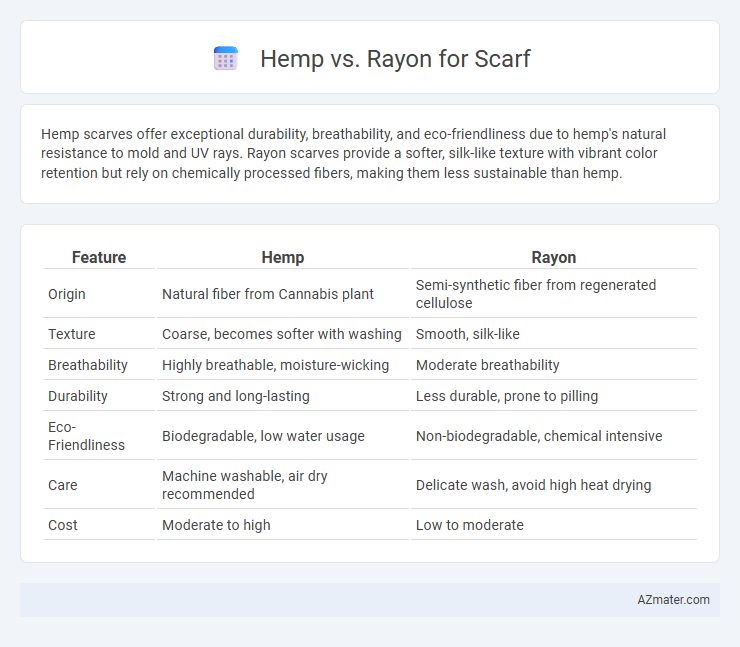Hemp scarves offer exceptional durability, breathability, and eco-friendliness due to hemp's natural resistance to mold and UV rays. Rayon scarves provide a softer, silk-like texture with vibrant color retention but rely on chemically processed fibers, making them less sustainable than hemp.
Table of Comparison
| Feature | Hemp | Rayon |
|---|---|---|
| Origin | Natural fiber from Cannabis plant | Semi-synthetic fiber from regenerated cellulose |
| Texture | Coarse, becomes softer with washing | Smooth, silk-like |
| Breathability | Highly breathable, moisture-wicking | Moderate breathability |
| Durability | Strong and long-lasting | Less durable, prone to pilling |
| Eco-Friendliness | Biodegradable, low water usage | Non-biodegradable, chemical intensive |
| Care | Machine washable, air dry recommended | Delicate wash, avoid high heat drying |
| Cost | Moderate to high | Low to moderate |
Hemp vs Rayon Scarves: An Overview
Hemp scarves are known for their durability, breathability, and eco-friendly properties due to hemp's sustainable cultivation and natural resistance to pests. Rayon scarves, often prized for their softness and vibrant sheen, are made from cellulose fibers derived from wood pulp, but their production involves chemicals that can impact the environment negatively. Choosing between hemp vs rayon scarves hinges on prioritizing sustainability and natural fiber benefits with hemp or opting for the smooth texture and color richness that rayon provides.
Material Origins: Hemp and Rayon Explained
Hemp is a natural fiber derived from the stalks of the Cannabis sativa plant, known for its durability, breathability, and eco-friendly cultivation with minimal pesticide use. Rayon is a semi-synthetic fiber made from regenerated cellulose, typically sourced from wood pulp, undergoing chemical processing to mimic the softness and drape of natural fabrics. Understanding hemp's renewable agricultural roots versus rayon's industrial transformation of natural materials highlights key differences in sustainability and fabric performance for scarves.
Environmental Impact: Sustainability Comparison
Hemp scarves have a significantly lower environmental impact than rayon, as hemp cultivation requires minimal water, no pesticides, and enriches soil health through crop rotation. Rayon production involves chemically intensive processes that release toxic pollutants and consume large amounts of water and energy, contributing to environmental degradation. Choosing hemp over rayon supports sustainable fashion by promoting renewable resources and reducing chemical pollution.
Durability and Longevity of Each Fabric
Hemp scarves exhibit exceptional durability due to their strong natural fibers, making them highly resistant to wear and tear over time. Rayon, while soft and smooth, tends to be less durable, often showing signs of pilling and weakening faster with frequent use. Hemp's longevity outperforms rayon, maintaining its structural integrity and appearance after multiple washes and extended wear.
Texture and Comfort: Wearing Experience
Hemp scarves offer a coarse yet breathable texture that softens with use, providing a durable and eco-friendly option for those seeking natural fibers. Rayon scarves deliver a silky, smooth feel that drapes elegantly and feels lightweight against the skin, enhancing wearer comfort during prolonged use. The contrast in texture results in hemp being preferred for rustic aesthetics and durability, while rayon excels in softness and fluidity for luxurious comfort.
Breathability and Moisture-Wicking Properties
Hemp scarves provide superior breathability due to their natural porous fiber structure, allowing excellent air circulation and moisture evaporation. Rayon, a semi-synthetic fiber made from cellulose, offers moderate moisture-wicking but lacks the enhanced ventilation found in hemp. Choosing hemp for scarves ensures better temperature regulation and dryness, making it ideal for all-day comfort in warm or humid conditions.
Style Versatility and Dye Affinity
Hemp scarves offer exceptional style versatility with their natural, textured appearance that complements casual and eco-conscious fashion, while rayon excels in providing a smooth, silky finish suitable for both formal and trendy looks. Hemp fibers have a moderate dye affinity, resulting in earthy, muted tones ideal for organic styles, whereas rayon's high dye affinity produces vibrant, rich colors that maintain brightness after multiple washes. Choosing between hemp and rayon scarves depends on the desired balance between sustainable style and vivid color expression.
Care and Maintenance Requirements
Hemp scarves require minimal care, thriving with gentle hand washing in cold water and air drying to maintain their natural texture and durability. Rayon scarves, being more delicate, need careful hand washing or dry cleaning to avoid shrinking and fabric damage, often requiring low-heat ironing to preserve softness. Proper maintenance extends the lifespan and appearance of both materials, with hemp offering greater resilience against frequent wear and washing.
Price Point: Affordability Analysis
Hemp scarves generally offer a higher price point due to sustainable cultivation costs and durable fiber production, making them a long-term investment in eco-friendly fashion. Rayon scarves tend to be more affordable because of lower manufacturing expenses and mass production efficiency, attracting budget-conscious consumers. Comparing the two, rayon presents immediate cost savings, while hemp provides better value for those prioritizing sustainability and longevity in their scarves.
Final Verdict: Choosing the Right Scarf Material
Hemp scarves offer durability, breathability, and eco-friendly benefits, making them ideal for consumers seeking sustainable, long-lasting accessories. Rayon scarves provide a soft, silky texture and vibrant draping but usually involve chemical-intensive production, which may impact environmental considerations. Selecting the right scarf material depends on prioritizing sustainability and robustness with hemp or opting for softness and aesthetic appeal with rayon.

Infographic: Hemp vs Rayon for Scarf
 azmater.com
azmater.com